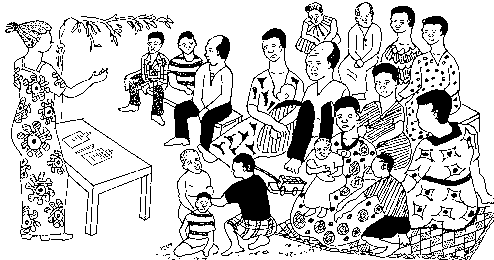Tweet
Translations:
'العربية / al-ʿarabīyah
Bahasa Indonesia
Català
中文 / Zhōngwén
Deutsch
English
Español
Ewe
Filipino/Tagalog
Français
Galego
Ελληνικά / Elliniká
हिन्दी / hindī
Italiano
日本語 / Nihongo
Kiswahili
नेपाली / Nepālī
Polszczyzna
Português
Română
Русский
Српски / Srpski
ไทย / Thai
Türkçe
اردو / Urdu
Èdè Yorùbá
Other formats:
Other Pages:
Modules
Site Map
Key Words
Contact
Utility Documents
Useful Links
COMMUNICATION BETWEEN EXECUTIVE AND PUBLIC
Pro-Active Transparency
by Phil Bartle, PhD
Training Handout
Action must not be secretive; the community members must know what is going on
Just as in your own work of mobilizing you need to be transparent, facilitating, non dictatorial, and involving the community in decision making, so you should also encourage the executive to be the same towards its community.
For maintaining good communications between the community and its executive, if carried out frequently, three useful methods are: meetings, reports, and inspections.
Public community meetings are the most important means of ensuring a good flow of information between the executive and the community as a whole. (Elaborate meetings may include celebrations noted in the next section). At meetings you want to encourage and train the executive to take a "facilitating" role as you have been doing as a mobilizer.
They need to develop good public speaking skills, avoiding speeches, lectures, sermons or pronouncements, learning to draw responses out of the participants. That two-way flow of information ("dialogue" means "two-way"), assists in increasing transparency and promotes good governance, participatory management and democracy.
Reports are important, too. They should be well written in very simple language, and should be verbally announced at community meetings. Seek community responses.
Inspections, where the community members walk around the project site with the executive, also encourage good communication and transparency.
Posters and posted notices can assist in a good flow of communicating, but should not be used alone. They can complement public meetings but not substitute for them. They may be focussed on raising awareness, or on reporting the results of project activities.
A statement of accounts, including income and expenditures, posted on the clinic or school while under construction, improves transparency.
The important thing for you, as mobilizer, to emphasize is to encourage good governance, participatory management, integrity, transparency, by good communication between the executive and the community as a whole.
The degree to which you have learned facilitation methods of leadership contributes to the degree to which you can encourage and train the executive and the community leaders to learn and use them too.
––»«––
Community Gathering:
 |